Containment and Cleanup Tips (VIDEO)
Here are some suggestions to contain your blast debris and make clean up easy.
Clean Up Methods
Hard Surface

You can blast on a hard surface, like concrete. Sweep and shovel up all abrasive and paint removed and dispose of it properly. For a floor that is porous or difficult to clean, throw some heavyduty cardboard down. A little extra prep and money into prepping your area will save you valuable time when you're done blasting.
Plastic Sheet

Alternatively, place 6 mil plastic underneath and around the project. Be sure to secure the corners.
When the project is completed, it's likely that it will be too heavy to pick up the entire sheet of plastic at one time. We recommend cutting it into sections to make it easily manageable. In the video below, you can see the plastic sheet method of containment.
(Setup can be seen at 1:30 and cleanup can be seen at 3:58)
Debris Pickup Service
If you don't want to haul away spent media when the job is done, there are several disposal services that you can take advantage of.
Bagster is a dumpster in a bag. You can purchase the bag for around $28 at your local home improvement store or on our online store. Fill the bag with up to 3,300 lbs of material and arrange for Waste Management to come pick it up. The charge for collection may vary based on your ZIP code.
Also consider junk removal services such as 1-800-Got-Junk.
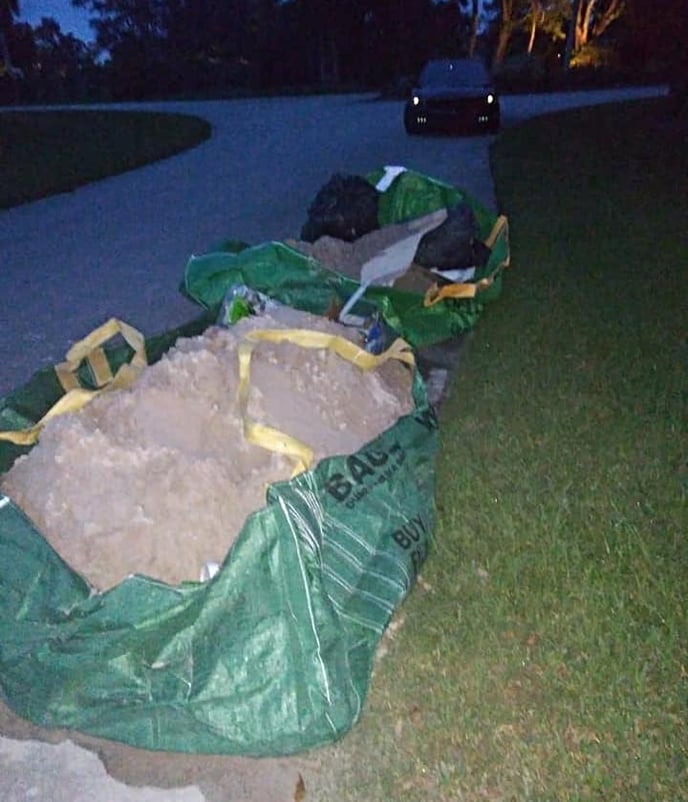
Bagster bags ready to be hauled away. Photo credit: Pro Blast of South Florida
Vacuum
This contractor uses a drum vacuum to clean up dry media from a hard surface.
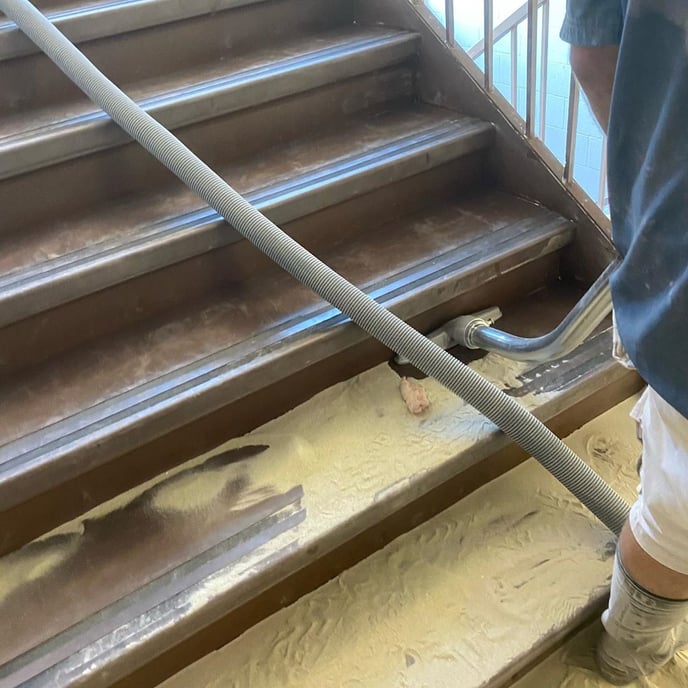
Photo and video credit: @h4blasting
Containment Methods
Curtains or Barriers
If you’re in a delicate place or situation, you’ll want to set up some simple curtains or barriers.
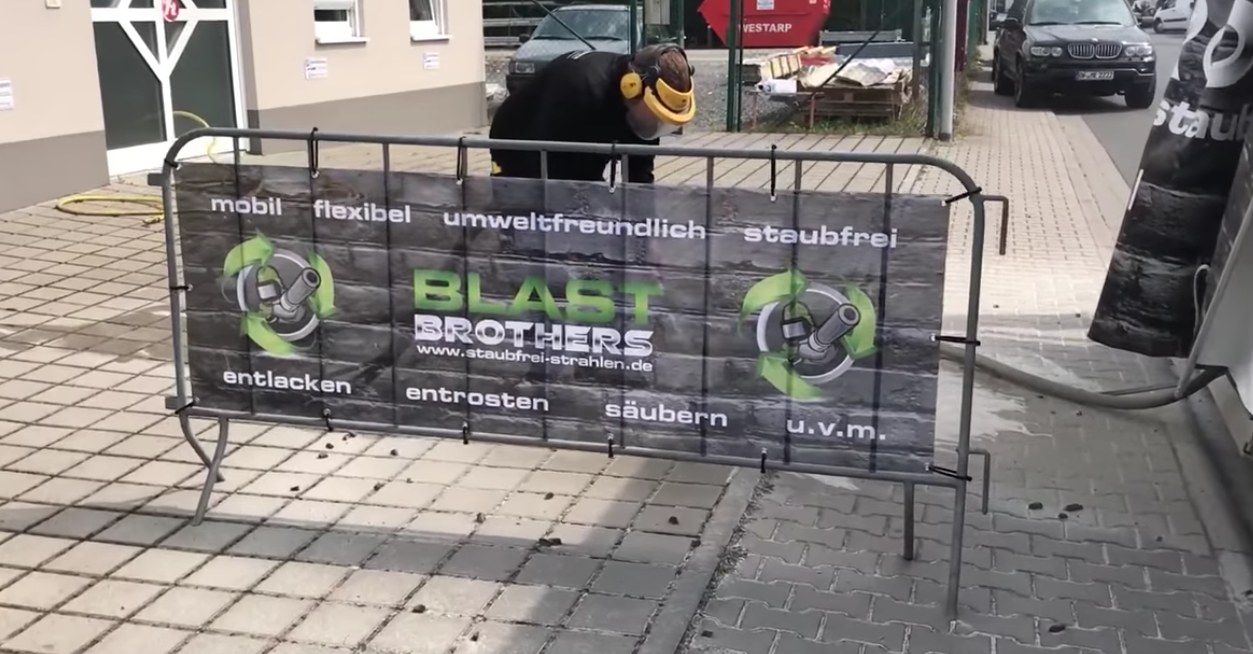
Photo credit: Blast Brothers
They have this simple barrier, and as a bonus it’s even branded with their business name and phone number! If you don’t want to set up a barrier to stop the media’s momentum, simply lay out a larger area of plastic.

Silt Fence
"Sediment containment barrier (the black fabric that is used by contractors) works great and is cheap and reusable. Comes in 100-ft rolls with stakes."
This will keep media out of unwanted areas, such as the customer's yard.
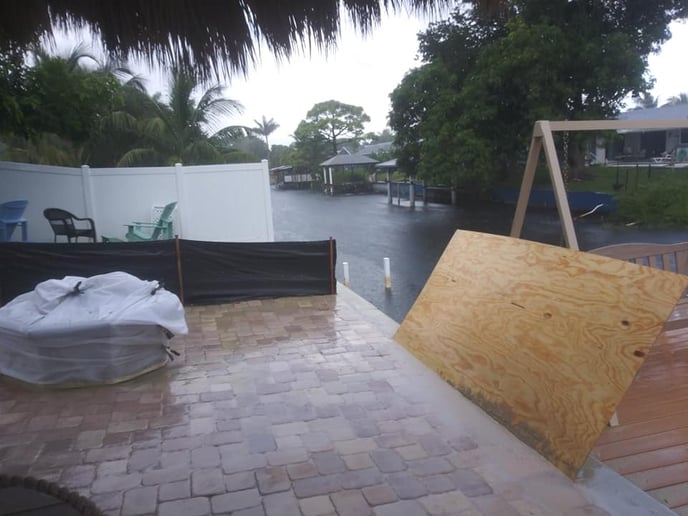
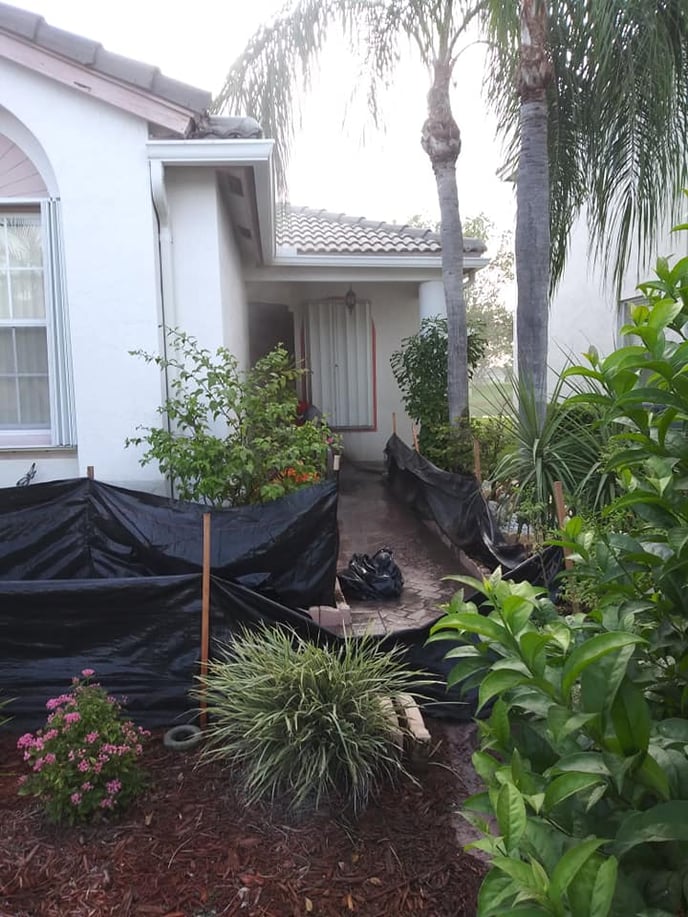
Silt fence used to protect landscaping. Photo credit: Pro Blast of South Florida
Blasting Indoors

Dust containment is very important indoors, or in any confined space. Consider using plastic sheeting and an air scrubber, as shown in the video below, to protect the customer's home.
Remember, always use a supplied air respirator such as the Nova 3®, when blasting in a confined space. This goes for dry OR wet blasting.
Related Article: Choosing the Right Abrasive
For Curb Paint
With curbs, try having a helper walk with with you, holding a blast shield, and blast towards the shield. When your helper moves with you, you don't have to worry about setting up containment along the entire length of the curb, you only need one small piece.
Here's what our contractors say:
- "You can just use a simple piece of plywood."
- "Make yourself a blast shield. Two wheel barrel handles bolted to a piece of thin sheet metal 4ft wide x 2ft high."
- "I made one of a rubber corrugated roofing panel that folded up. Worked really good when getting close around cars."
- "You may want to put sand bags or barriers around drains along the curb, to prevent stray media from going down the drain."
- "If you are blasting curbs near traffic, it might be useful to use a 2-way radio, so your spotter can communicate with the hose guy when there is approaching traffic. If possible, blast during low traffic hours, like 10pm - 6am."
For Stripes / Parking Lot Markings
"I have a box built 1 foot high by 4 foot long that I blast my lines and contain it as best as possible. Just blast and slide."
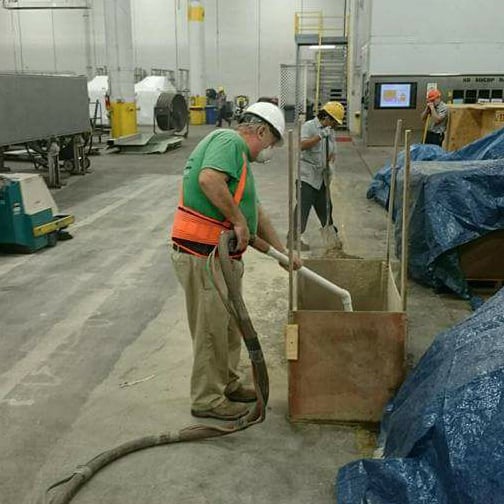
If outdoors, can be a good idea to rent a street sweeper to clean up after blasting. You can factor that into your quote, and pass the cost onto the customer.
For Fire Hydrants
Here are some great ideas from our business owners:
"As I walked through Home Depot trying to think of something to put down to keep the dirt from kicking up around the base of the hydrants, I came across these 4’x3’ tin flashing pans for roofs. Took one and cut in half and cut out half circles. Put duct tape on the cut edge since it was pretty sharp, but all in all it worked out great and is lightweight. I was going to use wood, but thought it would probably get weighed down from all the media and water. I did 23 fire hydrants today and averaged 5 minutes blasting and probably 2 minutes setting up at each hydrant."
— Peedee's Blasting
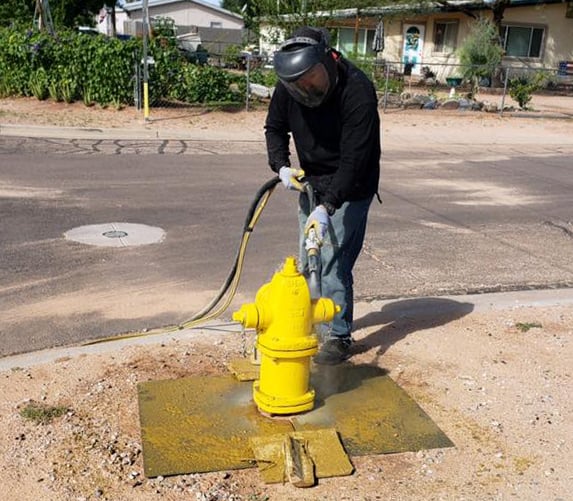
Photo credit: Peedee's Blasting
"We did 100's [of fire hydrants] for a city or two, we did some wet, some dry. 220 dollars each. Used a piece of rubber to fit around the whole thing to protect the grass or ground. That price was for just blasting. Remember you've got to drive to each one set up, blast, take your stuff down and then clean up, then drive to the next one. City was worried about contamination so we built a PVC plastic containment wall 4ft by 4ft to place around the hydrant. But we ended up not using it after our initial demonstration for the city people."
— Matt B.
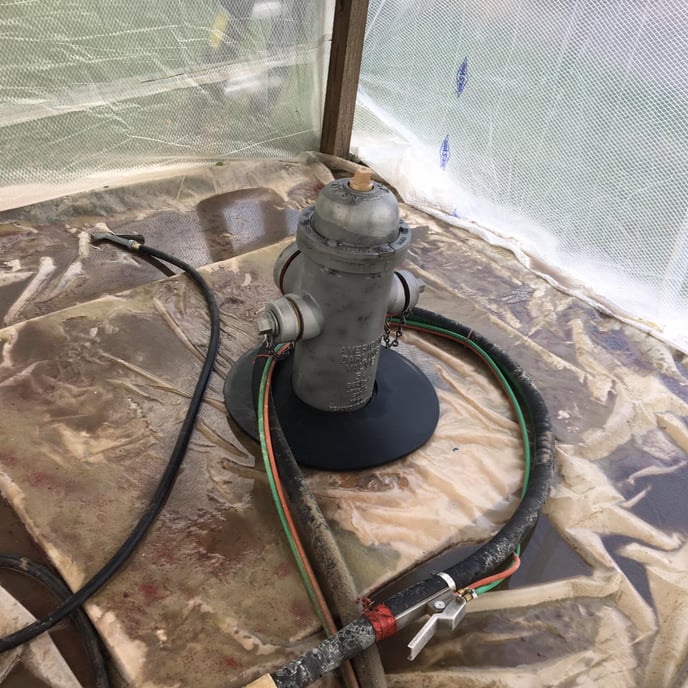
Photo credit: American Dustless Blasting
For Marine Blasting / Boats
In some cases, you may tent around the bottom of the boat for containment, as seen here:


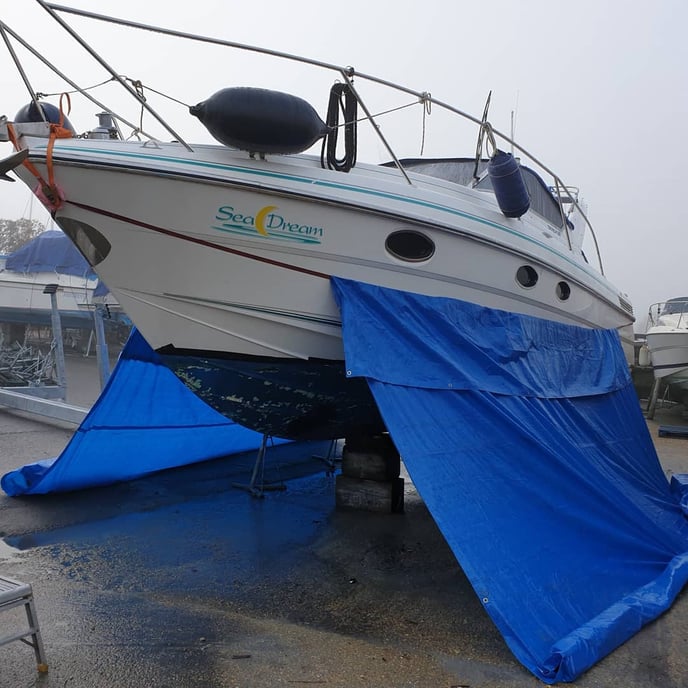
Photo Credit: @southern_dustless_blasting
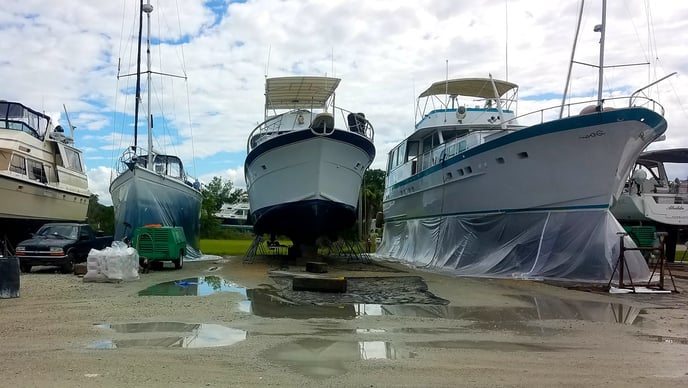
Photo credit: Douglas John Lee
"Put down a junkster bag first then a solid piece of plastic sheeting. Put the boat on top of that. Tent the boat, shoot it with 40/70 @ 50 pounds pressure. It will come right off and leave a nice profile on the gel coat. Roll up all the sheeting into junkster bag and cleanup is pretty much done. Tape off waterline with 2” blue tape and 2” gorilla tape on top of painters tape. Use another run of gorilla tape to hold plastic tent sheeting to the two layers of tape on waterline I use a big exhaust fan with a dust sock to help with dust underneath. I hope you have a nova 3 helmet or something similar to help you breath. $50 a foot all day long"
—Bert R.
"We put 2 air scrubbers on one end of the tent... left the other end open a bit... the scrubbers pulled the air thru the tent it kept it clear enough to blast. Believe they are 2500 com each.
I run 4 filters on them. The outer changed about every 30 minutes or so. And nothing gets out."
— Daniel Y.
For Swimming Pools / Pool Decks
"The last [pool deck] I did, I laid plastic down on the water, cut and taped it down, then dry blasted. Worked great, was able to blow the media off rather easy, got very very little media in the pool."
— Richard R.
Great idea, Richard. We might also suggest using some inexpensive pool noodles under the plastic to ensure it stays afloat.
"I have done many pool decks, and this is the most common issue. I blast away from the pool, and also identify drains in the deck that go to the pool filtration system. So tape off the drains, blast away from the pool, and tell the customer up front there will be "some" minor amount of media in the pool, but not usually more than the filter system can take care of, including a filter change. If they are not comfortable with that then don't do the job."
— Janis Y.
"Get in the pool and blast away from the edge. Once you have about a foot from the edge, drape plastic and weight down with whatever you have. Bottom line: just take every precaution to minimize media and paint from getting in the pool. Like you said, the pool vacuum should take care of the rest."
— Charles C.
"You will never keep 100% out but only trying to keep to a minimum. Depending on edge either cover it with 4 mil plastic and tape edges down or set up plywood as shield etc... Gotta get creative on situations like this. Plastic, tape, clamps, wood are your best friend. I also have a pool cleaner come behind me to vacuum pool out when we are complete"
— Patrick G.
